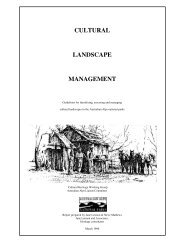Mining Heritage of the Australian Alps - Australian Alps National Parks
Mining Heritage of the Australian Alps - Australian Alps National Parks
Mining Heritage of the Australian Alps - Australian Alps National Parks
Create successful ePaper yourself
Turn your PDF publications into a flip-book with our unique Google optimized e-Paper software.
<strong>Mining</strong> <strong>of</strong> metals o<strong>the</strong>r than gold has been carried out within <strong>the</strong> study area. While undoubtedly some<br />
<strong>of</strong> <strong>the</strong> best expressions in <strong>the</strong> State <strong>of</strong> <strong>the</strong> various types lie here (eg wolfram at Mt Murphy, primary<br />
tin lodes at Mt Wills), base metals mining is a very minor historical <strong>the</strong>me in Victoria, in sharp<br />
contrast to New South Wales. For example, total recorded Victorian copper production to 1993 was<br />
only 1925 tonnes 9 .<br />
There are no mining fields within <strong>the</strong> Victorian section <strong>of</strong> <strong>the</strong> study area that have outstanding cultural<br />
heritage value at a State level.<br />
New South Wales:<br />
State significance for <strong>the</strong> Kiandra field is indicated in <strong>the</strong> following areas:<br />
• It best represents one extreme <strong>of</strong> conditions under which mining was carried out in New<br />
South Wales, and carries in its landscape and Alpine climate strong evidence <strong>of</strong> living<br />
and working conditions. The o<strong>the</strong>r extreme is probably best-represented by <strong>the</strong> Mt<br />
Browne goldfield, near Tibooburra in far-western New South Wales.<br />
NSW <strong>Heritage</strong> Office Criteria:<br />
* The place possesses rare aspects <strong>of</strong> NSW's cultural history;<br />
* The place is important in demonstrating <strong>the</strong> principal characteristics <strong>of</strong> a class <strong>of</strong> NSW's cultural places and<br />
cultural environments.<br />
• It has significant historical <strong>the</strong>mes relating to <strong>the</strong> importance attached to <strong>the</strong> discovery by<br />
<strong>the</strong> government <strong>of</strong> New South Wales, and <strong>the</strong> hopes and infrastructure invested in <strong>the</strong><br />
field as a potential solution to <strong>the</strong> State's economic woes and to ending <strong>the</strong> dominance <strong>of</strong><br />
<strong>the</strong> Victorian goldfields. This infrastructure included police stations, lock-ups and stables<br />
at regular intervals along major routes to <strong>the</strong> diggings, government infrastructure in<br />
Kiandra, and <strong>the</strong> Willis customs post on <strong>the</strong> NSW-Vic border to <strong>the</strong> south. While<br />
Kiandra itself proved a failure, it none<strong>the</strong>less heralded a gold-led recovery <strong>of</strong> <strong>the</strong> NSW<br />
economy, that was <strong>the</strong>n carried on by subsequent larger discoveries.<br />
NSW <strong>Heritage</strong> Office Criteria:<br />
* The place is important in <strong>the</strong> course <strong>of</strong> NSW's cultural history;<br />
* The place has <strong>the</strong> potential to yield information that will contribute to an understanding <strong>of</strong> NSW's cultural<br />
history.<br />
The Kiandra goldfield is <strong>the</strong> only mineral field within <strong>the</strong> New South Wales section <strong>of</strong> <strong>the</strong> study area<br />
with any production <strong>of</strong> note. However, its estimated 180,000 ounce aggregate production is small in<br />
State terms, and is relatively small even in terms <strong>of</strong> regional goldfields. To <strong>the</strong> north-west <strong>of</strong> <strong>the</strong><br />
Kosciusko <strong>National</strong> Park, <strong>the</strong> Adelong field has produced just under 700,000 ounces, while to <strong>the</strong><br />
east, <strong>the</strong> Araluen field produced almost 500,000 ounces and Braidwood over 650,000 ounces 10 . Even<br />
in Kiandra's first and peak year (1860), it only produced 17.6% <strong>of</strong> New South Wales' gold, and<br />
approximately 2.5% <strong>of</strong> <strong>Australian</strong> gold production. New South Wales and Victoria were <strong>the</strong> only<br />
significant gold producers in that year, with Victoria dominating. In 1861, this dropped dramatically<br />
to 3.6% and 0.6% respectively. These figures in turn plummetted fur<strong>the</strong>r in following years 11 .<br />
4.5.2 STATE SIGNIFICANT SITES<br />
Victoria<br />
Nine mining sites within <strong>the</strong> study area have been assessed as <strong>of</strong> State cultural heritage significance<br />
during <strong>the</strong> Victorian Goldfields Project, and been included in <strong>the</strong> Victorian <strong>Heritage</strong> Register (VHR).<br />
These sites have legislative protection under Part 4 <strong>of</strong> <strong>the</strong> <strong>Heritage</strong> Act 1995 (Vic). They are:<br />
9 "Mineral Notes, Copper", Roger Buckley, May 2000 (EMV, Note Series No MNM0006, ISSN 1443-3583).<br />
10 Figures taken from MinFact sheets No 54, 55 & 56, NSW Department <strong>of</strong> Mineral Resources, 1996.<br />
11 Percentages calculated from <strong>of</strong>ficial production figures <strong>of</strong> New South Wales & Victoria, quoted in "Select Documents in <strong>Australian</strong><br />
History", Manning Clark, 1955 (pp48-50 in 1977 paperback edition).<br />
23

















